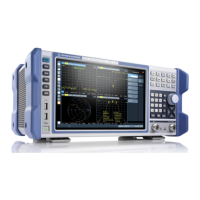VNA GUI reference
R&S
®
ZNL/ZNLE
352User Manual 1178.5966.02 ─ 20
The following display settings of a data trace and the associated memory traces are
fully coupled. Changing a property of one trace affects the properties of all other
traces.
●
All "Format" settings (see Chapter 10.8, "Format softtool", on page 415)
●
All "Scale" settings (see Chapter 10.3, "Scale softtool", on page 316)
Selection of the measured quantity (using the Meas softtool) is possible for the data
trace but disabled for the memory traces.
Channel settings made for a memory trace act on the associated data trace. Some of
the channel settings for a data trace (e.g. the "Stimulus" range) also affect the display
of the memory traces.
If, due to a change of the sweep type, the stimulus type of a data trace changes, all its
memory traces are deleted.
Active Trace vs. Active Data Trace
In the context of memory traces we distinguish between the active trace and the active
data trace.
●
If the active trace is a memory trace, then the active data trace is the data trace to
which the memory trace is associated.
●
If the active trace is a data trace, then the active trace is also the active data trace.
Data to <Destination>
Stores the current state of the active data trace to the Destination memory trace. No
trace functions are applied to the stored trace.
Tips:
●
Use Data & Func to <Destination> to apply trace functions to the stored trace.
●
You can also create memory traces using the Import Complex Data dialog.
●
It is not possible to store Hold traces to memory.
●
For the relation between a data trace and its associated memory traces, see "Cou-
pling of data and memory traces" on page 351.
Remote command:
CALCulate<Chn>:MATH:MEMorize
TRACe:COPY
Data & Func to <Destination>
Stores the current state of the active data trace – including trace functions – to the
Destination memory trace.
Trace functions
The trace functions comprise the following mathematical operations:
●
Active trace math on unformatted and formatted traces, as configured in the Chap-
ter 10.6.4, "Math tab", on page 355.
●
A shift of the data trace (see "Shift Trace" on page 384).
Data to <Destination> stores the raw trace without the trace functions, "Data & Func to
<Destination>" stores the trace after it has been transformed using the trace functions.
Trace softtool

